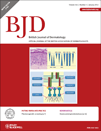Calcium homeostasis and body composition in patients with palmoplantar pustulosis: a case–control study
Funding sources This study was supported by grants from the Swedish Psoriasis Association, the Edvard Welander and Finsen Foundations, the Swedish Medical Society and the Medical Faculty of Uppsala University.
Conflicts of interest None declared.
Summary
Background Palmoplantar pustulosis (PPP) is a common disease strongly associated with smoking, autoimmune comorbidities and a deranged calcium homeostasis. It is unclear whether these changes in calcium homeostasis are a consequence of vitamin D status, abnormal dermal vitamin D synthesis or whether they are substantiated in effects on bone mineral density (BMD).
Objectives To study the vitamin D status and BMD in patients with PPP.
Methods In comparisons with two sets of controls (n = 101 for serum analyses and n = 5123 for BMD analyses), we therefore aimed to investigate whether PPP (59 cases) was associated with serum levels of 25-hydroxyvitamin D and 1,25-dihydroxyvitamin D, whether patients with PPP had decreased BMD and finally if the dermal expression of 25-hydroxyvitamin D3-1α-hydroxylase (CYP27B1) and the vitamin D receptor (VDR) were affected in PPP skin lesions.
Results We found no differences in mean serum 25-hydroxyvitamin D levels between cases and controls, whereas PPP cases displayed 17·8 pmol L−1 lower (P = 0·04) values in 1,25-dihydroxyvitamin D. BMD at the hip, lumbar spine or of total body did not differ substantially between cases and controls. Finally, patients with PPP had lower dermal expression of CYP27B1 and VDR in affected skin lesions.
Conclusions The increase in serum calcium levels and suppressed parathyroid hormone in patients with PPP were not attributable to derangements in vitamin D status and these patients did not have lower BMD.




